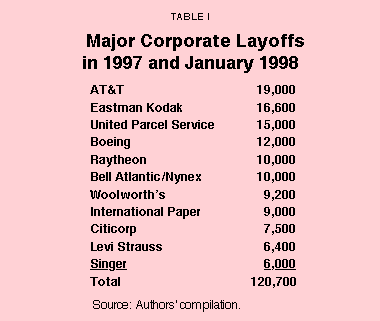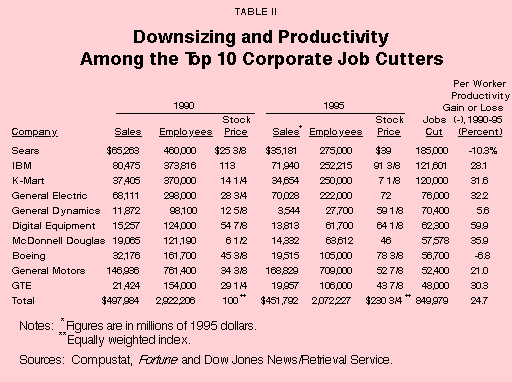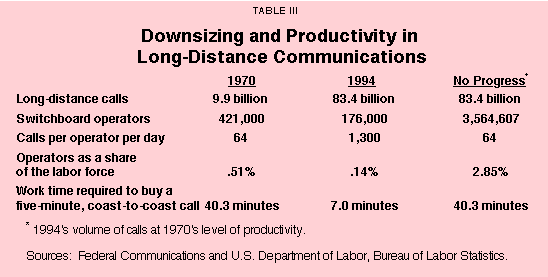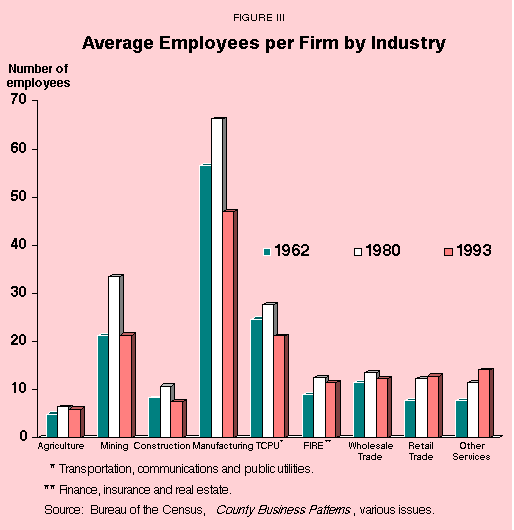1For America's economy, these are the best of times. Growth is strong. Inflation is tame. Robust job creation has pushed employment to a record 130 million. Unemployment has fallen below 5 percent, reaching lows not seen in a quarter-century. Productivity is showing solid gains. The stock market stands at record heights. Consumer confidence is buoyant. Just about every indicator of economic performance shows that the United States is hurtling toward the 21st century in fine shape, the "downsizing" crisis of the early 1990s fading away.
"The 72,193 layoffs announced in January 1998 was the highest monthly total in two years."
Yet every week or so there's a reminder that some American workers still face hard times. Even during the seventh year of this expansion, layoffs regularly shake the labor market. In 1997 and early 1998, Fortune 500 companies cut 120,700 jobs. There were 19,000 cuts at AT&T, 16,600 at Eastman Kodak, 12,000 at Boeing and 15,000 at United Parcel Service [see Table I].2
The outplacement firm Challenger, Gray & Christmas, Inc., which tracks corporate layoff plans, reports that job-cut announcements in the fourth quarter of 1997, at 152,854, were up 33 percent over their year-earlier level. The January 1998 total of 72,193 was the highest monthly number in two years.

"Today's job cutting shows that prosperous times do not eliminate downsizing."
Today's layoffs are smaller than the ones of just a few years ago, when the reports of lost jobs included 74,000 at General Motors, 60,000 at IBM, 50,000 at Sears and 40,000 at AT&T. A U.S. Department of Labor survey found that companies dismissed 17.4 million workers between 1990 and 1995.3 Even so, today's job cutting is enough to show that prosperous times do not eliminate downsizing. Americans seem to understand this. A recent survey by Princeton Survey Research Associates (PSRA) for USA Today and the Public Broadcasting System found that downsizing and restructuring have left workers feeling insecure.4
- Seventy percent of workers surveyed by PSRA said they have less job security than 20 or 30 years ago.
- Sixty-one percent of respondents blamed corporate mergers and downsizings for holding wages down.
Our instinct is to interpret job losses as a sign of failure – something wrong with the system or with us. To some people, downsizing signifies a breakdown in the loyalty that once held company and worker together. To others, it signifies personal defeat, a verdict that we, as workers, are no longer valuable human resources. Viewing layoffs as a malfunction, some of capitalism's critics go as far as to propose that government reward "good" companies that do not cut jobs and punish "bad" ones that do with taxes, sanctions and regulations.
Yet job losses are less harmful than they are often thought to be. To the contrary, the upside of downsizing lies in a reinvigorated economy. Indeed, the layoffs of the early 1990s can teach important lessons about how the economy operates to turn the bad news of lost jobs into the good news of higher living standards.
Upside: Laid-off Workers Get New Jobs. Layoffs aren't a sign of failure – not for the economy, not even for most workers. No doubt job losses hurt American workers and their families in the short term. But contrary to what is commonly assumed, most of these workers are rapidly reemployed, finding jobs as good as or better than those they lost. Downsizing cannot be understood apart from a broader view of the economy's health. More often than not, labor force turnover reflects positive market forces at work. Companies develop new or cheaper products, entrepreneurs pursue opportunities, factories and offices become more productive. In the process, new jobs inevitably replace old ones. The economy grows through a relentless process of turmoil, a continuous "churn" that economist Joseph Schumpeter called creative destruction. One of the great ironies of a free enterprise system is that the bad news of job losses is part and parcel of the good news of rising living standards.
"Job openings average 525,000 a month, more than double the typical growth of the labor force."
No one can guarantee that every displaced worker will readily find a good-paying job, but for most workers in the United States unemployment is brief. Job openings average roughly 525,000 per month, more than double the typical monthly growth of the labor force.5 Half of those who lose their jobs find another within six to eight weeks, two-thirds within 14 weeks and seven-eighths within six months. Recent studies show that most workers replace their old job with a new one that pays as well or better.6
Upside: Worker Incomes are Higher. Former Secretary of Labor Robert Reich and others have made much of the fact that average and median wages have increased little during the current economic expansion – while corporate profits, the pay of chief executives and stock prices have risen to record levels.7 However, the perception that average workers are not sharing in rising prosperity is wrong. For example:
- From 1974 through 1993, per capita real personal income increased an average of 1.4 percent a year.
- Real total compensation, which includes wages and benefits, rose about half a percentage point a year.8
The reason the good news is not reflected in wage rates is, in part, due to a long-term trend in workers' compensation: the percentage of the total compensation received by employees in the form of nonwage benefits – such as health care, payments for time not worked and pensions – has been increasing for more than 40 years. Employee benefits have grown from less than 19 percent of payroll in 1951 to nearly 42 percent today.9
Workers have preferred to take more of their compensation in nonwage benefits rather than wage income because benefits are often untaxed or taxed at a substantially lower rate than wage income. Thus workers value $1 worth of benefits more than $1 worth of wages. This is confirmed by the PSRA survey: when asked if they would rather have a pay raise or keep their benefits unchanged, 62 percent of workers said they would rather keep the benefits, while only 34 percent said they would take the raise.10
[page]
"Worker productivity at the top 10 job cutters grew nearly 5 percent per year, compared to about 1.5 percent in the overall economy."
A selection of recent downsizings will help illustrate in microcosm what's happening behind the handwringing and headlines. Table II presents a sample of 10 large U.S. companies that have shed labor, each mentioned repeatedly in accounts of America's layoffs.11 In total, they jettisoned almost 850,000 workers between 1990 and 1995. All of these companies employ fewer workers today than five years ago; thus the layoffs appear to be permanent. The companies and others like them are the ones criticized as hard-hearted and uncaring. As the table shows:
- After adjusting for inflation, the collective output of all 10 firms was down 9.7 percent.
- The companies used 34.4 percent fewer workers, however, so output per worker surged nearly 25 percent, or 5 percent a year.
- Thus their performance greatly exceeded the economy's average annual productivity gain of roughly 1.5 percent.12
Since rising productivity plays a vital role in rising living standards, it is incongruous to celebrate productivity gains yet denigrate downsizing.
That's not all. With the exceptions of Sears and Boeing, the companies in Table I emerged from downsizing more competitive and thus more likely to survive. Those who want to identify "good" firms and "bad" firms should take note: if firms don't survive, nobody has a job.
"Today's unemployment rate is 4.7 percent and the economy has added nearly 11 million new jobs, net of those destroyed."
More often than not, Wall Street approves of hard-nosed decisions to downsize as companies become more profitable and stock prices rise. Indeed, stock price gains among the companies listed in Table I averaged more than 130 percent from 1990 to 1995, compared to 86 percent for the S&P 500 companies overall.13 Investors should celebrate the gains. But what about the 850,000 employees who were cut? In a complex economy, there is no way to track each individual worker, but clearly most found jobs elsewhere. Today's unemployment rate of 4.7 percent is below that of 1990, and the economy has added nearly 11 million new jobs, net of those destroyed, in the past five years.
Many displaced workers are moving to new jobs in sectors of the economy that need labor in order to expand. As displaced workers take new jobs, they add to U.S. economic output. A precise calculation of their contribution is impossible, but suppose in their new jobs, the displaced workers produce the average output of an American worker – roughly $58,000 a year. In that case, the 850,000 workers from just 10 downsizing firms would have increased the country's GDP by $49 billion by moving from jobs where they were no longer needed to jobs where they are contributing to the national output of goods and services.
[page]
"Downsizing" may well be the new buzzword for layoffs, but it has been going on for centuries. In 1800, for example, it took nearly 95 of every 100 Americans to feed the country. In 1900, it required 40. Today, it takes just three. [See Figure I.] The downsizing of agriculture hasn't left the country hungry. To the contrary, the United States enjoys agricultural abundance – and much more. The workers no longer needed on the farm are available to provide new homes, computers, pharmaceuticals, appliances, medical assistance, movies, financial advice, video games, gourmet meals and a dizzying array of other goods and services. We would have far fewer consumer choices today if farming had not endured one of history's most drastic downsizings.
Most of the exodus from farming occurred generations ago, so Americans today have scant memory of the dislocations it caused. What we have instead is the abundance that comes from allowing the churn to deliver the bounty of higher productivity, wherever and whenever it occurs.
"The downsizing of agriculture from 93 percent of workers in 1800 to 3 percent today – hasn't left the country hungry."
Telephone service is another rich example of how the economy as a whole benefits as some workers lose their jobs [see Table III]. In 1970 the industry employed 421,000 switchboard operators, and Americans made 9.9 billion long-distance calls. By 1994 Americans were making 83.4 billion long-distance calls. Yet new switching technology allowed telephone companies to downsize to 176,000 operators.14 The telecommunications industry could do more with less because of a surge in productivity.

- In 1970 the industry handled only 64 calls a day for every operator, but by 1994 the volume of calls handled by each operator jumped to 1,300 – a staggering gain.
- Without the boost in efficiency, today's volume of long-distance traffic would require 3.6 million operators, or 2.9 percent of our labor force, instead of the 0.14 percent it actually takes.15
- Americans would be worse off in two ways: we would lose the goods and services 3.4 million workers now produce elsewhere in the economy, and we would pay six times as much for our long-distance telephone calls.16
Viewed in macrocosm and with the benefit of hindsight, it is easier to see that downsizing is simply conservation – recycling the economy's valuable labor resources.
[page]
"Without new technology, long-distance calls would cost six times as much and requires 3.6 million operators."
Shedding labor allows companies to adapt to changes in the marketplace. More often than not, downsizing is a matter of sheer survival. Companies with surplus labor usually have higher production costs and risk losing business to "lean and mean" competitors that can lure away customers with lower prices. Market discipline – in effect, consumers' scrutiny – pushes relentlessly at companies, forcing them to economize on resources, including labor.
Trend Toward Smaller Firms. Each company must determine its own "right" number of employees, but there is evidence that average firm size has been shrinking in most industries. In effect, the whole economy has been downsizing.
- From the early 1960s to 1980, the average company grew from 13.0 employees in 1962 to 16.3 in 1970 and to 16.5 in 1980. At the peak in 1970, roughly 37 percent of Americans worked in firms of 250 or more employees [see Figure II].
- In the past decade or so, the trend has gone the other way. The average number of employees per firm slipped to 14.8 in 1993 with only 29 percent of workers employed by firms of 250 or more.17
"The average firm size has been shrinking; in effect, the whole economy has been downsizing."
Downsizing has occurred in a broad spectrum of industrial categories – manufacturing; mining; construction; agriculture; wholesale trade; finance, insurance and real estate; and transportation, communication and public utilities [see Figure III]. Average firm size has continued to grow in only two broad sectors. Retail trade went from an average of 12.3 workers in 1980 to 12.7 in 1993. Companies in the catchall category called other services, which includes the health care, entertainment and information industries, expanded from 11.3 to 14.1 employees on average.

Computers Increase Productivity. Why are companies getting smaller? One reason may be the computer, an innovation that has touched many industries.18 Computers were rare two decades ago but are now almost ubiquitous. In fact, half of American workers now use computers on the job. The devices have become less expensive and more powerful as they have become widespread, allowing people to work more quickly and efficiently – increasing productivity. For example, with a computer a secretary can quickly revise and print the boss' correspondence (or workers can do their own), reducing the need for a typing pool. Using hand-held devices, salespeople can submit orders with a keystroke or two, cutting the need for personnel to process paperwork. In steel mills, automobile plants and other factories, computers control the production process, allowing one technician to do what once took dozens of workers. And with the advent of the Internet, individuals are increasingly able to locate and download information that once might have taken a small staff.
"Only in retail trade and the catchall 'other services' category has the number of employees per firm grown."
The computer might also help to explain why the average firm size in retail and many other services hasn't declined. More than mining or manufacturing, these businesses rely on one-on-one contact with customers, a task ill-suited to the computer. Thus, firms in these sectors do not get the same benefits from trimming employment.
[page]Even if unemployment is brief, it is unsettling, and societies are always tempted to look for ways to avoid layoffs. Policies to save existing jobs, however, will not make Americans better off. The economy will remain vibrant and forward-moving only if it can redistribute its labor resources in response to changes in demand and advances in technology. Efforts to protect jobs by short-circuiting the churn invariably produce higher unemployment, slower job growth and lower productivity growth in the long run.
A comparison between the United States and the European Community bears this out. While America's labor market remains relatively unregulated, many EC nations, hoping to thwart job losses, have saddled employers with burdensome rules on when and how workers can be dismissed. The red tape and reproach firms face if they attempt to cut jobs make them wary of hiring new workers in the first place. With few new opportunities opening up, workers cling to existing jobs. As a result, too many of Europe's labor resources remain frozen, and companies cannot respond quickly and aggressively to changes in the market.
"Europe's efforts to save jobs have instead resulted in unemployment rates of 10 percent or more."
The EC may have managed to "save" a few existing jobs, but the cost in economic performance has been high. Growth is slower. Productivity gains are meager.19 And workers have fewer prospects.
- The United States has added 15 million jobs since 1990, a gain of 13 percent, while the EC has created 5 million, or just 3 percent.
- For most of this decade, unemployment in the EC has been at 10 percent or more, double the U.S. rate.
- Worse yet, more than 5 percent of the EC's labor force has been out of work for a year or more, while in the United States the figure is less than three-fourths of 1 percent.
Some may say that downsizing has "gone too far."20 There's no denying the upheaval caused by letting economic forces work. Yet we cannot ignore the much greater cost that would be imposed by forcing companies to maintain the status quo. To society, the valuable resource clearly is the worker, not an existing job. Efforts to preserve jobs may well succeed, but these policies will rob the economy of its vitality and deprive this generation and future ones of the progress that lifts living standards. Indeed, what makes the American economy so strong is our willingness to endure the churn and let it enrich our economy over and over again.
NOTE: Nothing written here should be construed as necessarily reflecting the views of the Federal Reserve Bank of Dallas or the National Center for Policy Analysis or as an attempt to aid or hinder the passage of any bill before Congress.
[page]- An earlier version of this backgrounder was published as W. Michael Cox and Richard Alm, "The Upside of Downsizing," Southwest Economy, November/ December 1996, Federal Reserve Bank of Dallas.
- Compiled from various news reports by the authors.
- "Worker Displacement During the Mid-1990s," U.S. Department of Labor News, August 22, 1996.
- Beth Belton, "70 percent of Workers Feel Less Secure About Jobs," and "Downsizing Leaves Legacy of Insecurity," both USA Today, August 29, 1997. The poll was conducted in mid-July 1997.
- Job openings data are monthly averages for 1993-95 and are the most recent available.
- Council of Economic Advisers, "Job Creation and Employment Opportunities: The United States Labor Market, 1993-1996," a report from the Council of Economic Advisers with the U.S. Department of Labor, Office of the Chief Economist, April 23, 1996.
- Robert Reich, "Has Downsizing Gone Too Far?" Challenge, July-August 1996, pp. 4-10.
- Per capita personal income and total compensation deflated using the CPI-UX1 consumer price index. See W. Michael Cox and Beverly J. Fox, "What's Happening to Americans' Income?" Policy Backgrounder No. 138, January 29, 1996, National Center for Policy Analysis. Regarding the role of the consumer price index, see Boskin Commission, "Toward a More Accurate Measure of the Cost of Living: Final Report to the Senate Finance Committee." Advisory Committee to Study the Consumer Price Index, December 4, 1996.
- U.S. Chamber of Commerce, "Employee Benefits Historical Data 1951-1979" and "1996 Employee Benefits Report."
- Beth Belton, USA Today.
- By and large, the companies reviewed here reduced their labor forces through layoffs rather than divestitures, although this distinction is not a critical one. Restructuring by any means – downsizing, divestiture, merger, acquisition, leveraged buyout and so forth – will typically have both employment and output effects for the firm, and thus can be investigated in terms of its effect on productivity.
- Productivity in this study is calculated as output per worker rather than output per hour, as it is typically measured.
- Moreover, at 3.13 percent, the dividend yield for the 10 stocks listed in Table I averaged more than that (2.88 percent) for the S&P 500 companies over the 1990-95 period. Reinvesting all dividends, a $100 investment at year-end 1990, spread equally across each of the 10 firms listed in Table I, would have grown to $269.16 (an average annual rate of 21.9 percent), as compared with only $214.95 (16.5 percent annually) for an S&P 500 investment.
- Federal Communications Commission, Statistics of Communications Common Carriers, 1994-95 (Washington, D.C.: U.S. Government Printing Office, 1995). At the same time jobs have been pared from this segment of the telecommunications industry, they have been added to others. Employment in the cellular telecommunications segment, for example, increased from 15,927 at the beginning of 1990 to 68,165 by the end of 1995, for a net gain of 52,238 jobs in six years.
- U.S. Department of Labor, Bureau of Labor Statistics, Employment and Earnings, September and various issues, 1996. Hourly wages of telephone operators also grew at a pace one-third to one-half better than average during the 1990s. From 1990 to 1995, operators' hourly wages increased at an average rate of 4.04 percent annually, compared with only 2.66 percent for all other clerical workers and 2.91 percent for hourly employees as a whole.
- Figures are based on the amount of work time required for a typical manufacturing employee to afford a five-minute daytime residential call from New York to Los Angeles, calculated as the price of the call divided by average hourly manufacturing wages. For 1970 this calculation is ($2.25/$3.35) = 0.67 hours = 40.3 minutes, and for 1994 the figure is ($1.40/$12.06) = 7.0 minutes. Based on AT&T's new One Rate Plan (15 cents anytime, anywhere), the 1996 work time figure is 3-1/2 minutes.
- Data are the most recent available.
- One other important factor is the increasing tendency for firms to outsource such functions as payroll and accounting to smaller firms that can do them more efficiently.
- GDP and productivity (output per worker) growth averaged 1.5 percent and -0.1 percent, respectively, in Europe over the 1990-95 period, while in the United States growth averaged 2.5 and 1.5 percent, respectively.
- Reich, "Has Downsizing Gone Too Far?"